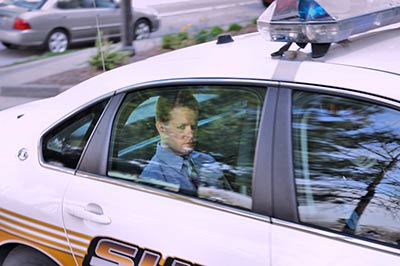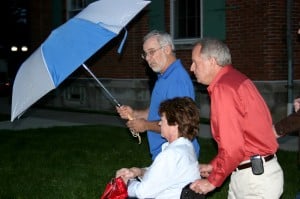Coleman trial now under way in Waterloo

Chris Coleman arrives at Monroe County Courthouse.
Monroe County State’s Attorney Kris Reitz began his “very comprehensive” case against accused murderer Christopher Coleman Monday morning at the Monroe County Courthouse in Waterloo.
Testimony continued Tuesday and is expected to last through this week and next, and possibly longer.
“There’s going to be a lot of evidence,” he said to the chosen jury of 10 women, two men and four male alternates from Perry County during his opening statement Monday morning. “Just take it all in.”
The jury is bused in daily from Pinckneyville by the Monroe-Randolph Transit District.

Pictured is the jury being bused in from Pinckneyville via the Monroe County Transit District.
Reitz said he intends to call at least 40 witnesses during the trial, which has put this county in the regional and national media spotlight.
Meanwhile, Coleman defense attorney Bill Margulis opened by asking the jury to “keep an open mind,” adding there’s no physical evidence linking his client to the crimes and he has “cooperated with police in each and every way.”
Coleman is charged with the May 5, 2009, strangulation deaths of wife, Sheri, and young sons, Gavin and Garett, inside the family’s Columbia home.

Pictured are wife Sheri Coleman and sons Garett and Gavin.
Reitz intends to seek the death penalty should Coleman be convicted, although a state law instituting a death penalty ban takes effect July 1. Gov. Pat Quinn has said he will commute all current and future death sentences imposed before that date.
Coleman has entered a not guilty plea to the crimes.
Police say evidence points to Coleman committing the murders out of frustration that he could not divorce his wife without losing his six-figure salaried job as security chief for televangelist Joyce Meyer.
Investigators contend Coleman was having an affair with a Florida woman named Tara Lintz, something defense attorneys do not deny.
Lintz attended the same Florida high school as Sheri Coleman and the two had been friends.
She is expected to testify in court on Thursday.
Police also say evidence suggests emailed and mailed threats and messages left in spray paint on the walls inside the family’s home can be traced back to Coleman himself.
In a courtroom consisting of five rows for audience seating at 10 or 11 persons per row, the average trial day is watched by six to eight members each from Chris and Sheri’s families, roughly 13 members of the media, plus limited seating available to the general public.
The jury has appeared calm throughout the trial, even as graphic crime scene and autopsy photos are shown.

Monday
In his opening remarks, prosecuting attorney Reitz said Coleman couldn’t let the ministry know about his affair and that friends of Sheri will testify that Chris wanted a divorce.
“She was ruining his life,” Reitz told the jury.
Reitz said a computer expert will tell jurors that email threats in this case can be traced to Coleman’s own computer, and a linguist will say threat letters and spray-painted messages share similarities with known Coleman writings.
“Bear with me,” Reitz asked the jury in reference to the mountain of evidence he plans to present. “This case is too important to leave anything out.”
Defense attorney Bill Margulis countered in his opening that evidence will show Coleman was a “wonderful father” who was very involved with his children.
The couple had worked through “communication problems” and the strain of his traveling a lot for work, Margulis added.
As for supposed evidence linking Coleman to email threats, the defense attorney said others knew his passwords and “anyone with access to his computer” could’ve sent them.
Sheri’s mother, Angela DeCicco, was the first to take the stand Monday, tearfully identifying her daughter and two grandsons to Reitz from a family photograph.
She then left the courtroom in tears early in the testimony of Columbia police officer Jason Donjon. Graphic crime scene photos of all three victims laying dead in their beds, Sheri naked, were shown on a large screen behind the defendant at this time.
Donjon provided a step-by-step account of his arrival on the scene, the discovery of spray-painted obscenities throughout the home, and ultimately the dead bodies of Sheri, Garett and Gavin.
Coleman appeared to hold back tears upon the display of crime scene photos, but mostly looked away from the screen.
Donjon observed that, in all three victims, their bodies were cold to the touch, with skin described as “tough” and “thick.” Sheri’s neck, head and upper arm were “locked into place” when he attempted to roll her over, he said.
Donjon said this seemed to indicate to him the victims had been deceased for some time, though the officer admitted under cross-examination he had no formal specialized training on the matter.
Police have said Coleman told them his wife and two sons were alive when he left at 5:43 a.m. that day to work out at a South County gym.
Following a lunch break, Reitz called fellow Columbia police officer Steve Patton, who discovered Gavin’s lifeless body on his bed and also said it was cold to the touch.
Patton added he had responded to the Coleman residence before, following a Jan. 2, 2009, report made by the defendant that a threat letter had been found in his mailbox.
Columbia paramedic Gary Hutchison testified Monday that upon his arrival on scene, Coleman “appeared to be crying” outside the home. He also testified that rigor mortis had set in on all three victims, leading him to believe they had been dead for some time.
The defense pointed out that Hutchison failed to mention rigor mortis as part of his initial report, to which he replied it was an oversight.
Others called to the stand in the trial’s first day included Madison County Coroner’s official Debra Von Nida, who testified to the body temperatures of the victims, as well as medical examiner Dr. Raj Nanduri, who performed the autopsies.
Von Nida said she took the body temps of Sheri and Garett, but not of Gavin. This was because Gavin had a spray-painted expletive near his body and strands of dark hair on his right arm that were considered as evidence.
Nanduri, who said she was merely called on to determine a manner of death in the case, estimated just on body temperature alone the victims were deceased “sometime between 3 and 5 a.m.”
She admitted under defense questioning, however,”there’s always a range” when determining time of death, including the person’s body size, amount of clothing worn and temperature of room.
“We never have laboratory settings for death, sir,” she told defense attorney James Stern.
Others testifying Monday included FBI veteran Sharon Leach, who created a small replica of the Coleman home as part of the investigation, and Columbia EMS responder Jared Huch.
Tuesday
Time of death was a hot topic at the start of day two in the Coleman trial.
Dr. Michael Baden, a nationally recognized forensic pathologist and medical examiner who has testified in such high-profile cases as the O.J. Simpson trial, said that upon examination of factors such as rigor mortis, lividity and body temperature, all three victims were dead “definitely before 5 a.m.” and probably before 3 a.m.
“It wasn’t a close call,” Baden said of his finding.
Dark strands of hair found on Gavin’s right arm led Baden to conclude he was strangled by the same ligature as his mother, with her hair transferred onto him.
Under cross-examination, the defense tried to show that the rate of the victims’ body temperature drops were consistent with being killed around the time Coleman left at 5:43 a.m.
But Baden said body temperature usually stays stable for a few hours after death, and then declines. He added that rigor mortis and lividity are more important factors.
The defense asked Baden about cases in which rigor mortis sets in immediately upon death, to which Baden testified that this was rare and wasn’t the case here.
Once again, photos of the deceased victims were shown in court. Coleman wiped tears towards the end of Baden’s direct examination and breathed heavily throughout, but looked down at the table and away from the screen the entire time.
A central figure in the investigation and eventual arrest of accused murderer Christopher Coleman testified Tuesday afternoon.
Former Columbia police detective sergeant Justin Barlow, a neighbor of the Colemans arrived first on scene May 5 at the defendant’s request.
Barlow, now a deputy U.S. Marshal, testified he lived on Micah’s Way at the time of the murders — just caddy-corner from the Coleman residence on Robert Drive in the Columbia Lakes subdivision.
A surveillance camera was installed in Barlow’s residence to monitor the front of the Coleman home due to reported threats received by the defendant via email and in the family’s mailbox, he said.
Barlow had also exchanged phone numbers with Coleman as part of this surveillance arrangement, he said.
Footage of the Coleman home captured on this camera and shown Tuesday shows Coleman pulling forward out of his driveway and to a South County gym at 5:43 a.m. on May 5, 2009.
Other than a man walking his dog and a few cars passing by the home in between, nothing unusual was observed on the video between that time and 6:51 a.m., when Barlow is seen walking over from his home to check on the family as Coleman had asked him to do.
Barlow also noted that Coleman told him he was calling from the J.B. Bridge during this “welfare check” request at 6:43 a.m., which awakened an off-duty Barlow that morning.
But Coleman didn’t arrive at the home until 6:56 a.m., as the video shows — a full 13 minutes later.
Barlow said it typically took him seven minutes to get home from the bridge in similar conditions. Prosecutor Kris Reitz had mentioned in his opening remarks that one of Coleman’s cell phone calls that morning had bounced off a cell tower in Dupo.
Barlow also testified that a window of the walk-out basement in the Coleman home was open and its screen placed up against the patio area upon his arrival. However, he noticed no signs of forced entry.
Once inside, Barlow detailed the same crime scene as other police officers testified to on Monday: spray-painted messages on walls and the bodies of three strangled victims in their beds, cold to the touch.
Barlow also said Coleman was standing in the kitchen area just after officers had found the bodies, asking them what had happened.
“I said, ‘Chris, they didn’t make it,” Barlow testified.
Aside from crying, Barlow said Coleman made no attempt to go upstairs and offered little resistance as officers escorted him outside.
Tuesday’s testimony ended less than two hours into a six-hour video of Coleman being interviewed by investigators at the Columbia Police Department around 11 a.m. on the day of the murders.
It begins with Coleman sitting down to talk with Barlow and another investigator; he is seen openly weeping.
As this was shown in court, Coleman’s mother, who sits in a wheelchair, was escorted out of the courtroom by his father with tears in her eyes.

Coleman family
The interview mostly touched on the family’s whereabouts and timeline of May 4-5, 2009.
Coleman, who was off work on May 4, tells police he picked up the kids from school and played catch with Garett that afternoon while Sheri was working.
The family had dinner together that evening and went and got snow cones in town before watching TV and settling down for the night, he tells police.
Coleman also goes to work out at Pound4Pound Fitness in Waterloo at some point in the evening before returning home to bed.
Coleman then tells police on video that he woke up at 5:30 a.m. and left for Gold’s Gym in South County. His first text to Sheri was at 5:43 a.m. — the same time video surveillance from Barlow’s home shows his Ford Explorer leaving the driveway.
The police video was paused for the day following a five-minute break in the interview by investigators.
During this period of the video, Coleman is seen alternately weeping and sending/receiving texts on his phone while alone in the room.
The remainder of this police interview was expected to be shown in court Wednesday.






